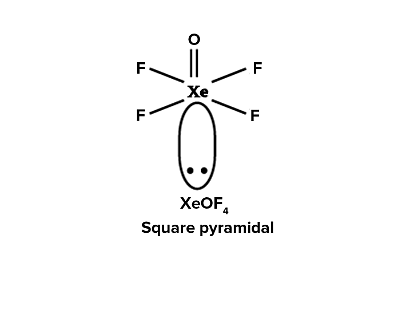Which of the following have square pyramidal structure?
- XeOF4
- BrF3
- XeF4
- XeO3
The Correct Option is A
Solution and Explanation

XeOF₄ and its Structure:
- Chemical Formula: XeOF₄ (Xenon oxytetrafluoride).
- Central Atom: Xenon (Xe).
- Electron Pair Arrangement:
- Xenon has 8 valence electrons.
- 4 fluorine atoms and 1 oxygen atom are bonded to Xenon.
- 1 lone pair remains on Xenon after bonding.
- Molecular Geometry: Square pyramidal (AX5E type) due to the presence of:
- 5 bonded groups (4 fluorine atoms + 1 oxygen atom).
- 1 lone pair, which distorts the structure into a square pyramidal shape.
Key Observations:
Due to the lone pair of electrons on Xe, the molecule adopts a square pyramidal geometry. This geometry is confirmed by VSEPR (Valence Shell Electron Pair Repulsion) theory, where the lone pair repels the bonded atoms, causing this specific shape.
Conclusion:
The correct answer is: XeOF₄ has a square pyramidal structure.
Top Questions on Chemical bonding and molecular structure
- A group 15 element forms \( d\pi - d\pi \) bond with transition metals. It also forms a hydride, which is the strongest base among the hydrides of other group members that form \( d\pi - d\pi \) bonds. The atomic number of the element is ________________________.
- JEE Main - 2025
- Chemistry
- Chemical bonding and molecular structure
Identify the correct orders against the property mentioned:
A. H$_2$O $>$ NH$_3$ $>$ CHCl$_3$ - dipole moment
B. XeF$_4$ $>$ XeO$_3$ $>$ XeF$_2$ - number of lone pairs on central atom
C. O–H $>$ C–H $>$ N–O - bond length
D. N$_2$>O$_2$>H$_2$ - bond enthalpy
Choose the correct answer from the options given below:- NEET (UG) - 2025
- Chemistry
- Chemical bonding and molecular structure
- Identify the geometry and hybridization of the central atom in SF₄.
- BITSAT - 2025
- Chemistry
- Chemical bonding and molecular structure
- What is the bond order for diatomic carbon according to molecular orbital theory?
- AIIMS Paramedical - 2025
- Chemistry
- Chemical bonding and molecular structure
- Which of the following has $\text{sp}^3\text{d}^2$ hybridisation?
- JEE Main - 2025
- Chemistry
- Chemical bonding and molecular structure
Questions Asked in JEE Main exam
0.01 mole of an organic compound (X) containing 10% hydrogen, on complete combustion, produced 0.9 g H₂O. Molar mass of (X) is ___________g mol\(^{-1}\).
- JEE Main - 2025
- Organic Chemistry
- In the Claisen-Schmidt reaction to prepare dibenzalacetone from 5.3 g benzaldehyde, a total of 3.51 g of product was obtained. The percentage yield in this reaction was _____.
- JEE Main - 2025
- Reaction Mechanisms & Synthesis
- The sum of all local minimum values of the function \( f(x) \) as defined below is:
\[ f(x) = \begin{cases} 1 - 2x & \text{if } x < -1, \\[10pt] \frac{1}{3}(7 + 2|x|) & \text{if } -1 \leq x \leq 2, \\[10pt] \frac{11}{18}(x-4)(x-5) & \text{if } x > 2. \end{cases} \]- JEE Main - 2025
- Functions
- Two balls are selected at random one by one without replacement from a bag containing 4 white and 6 black balls. If the probability that the first selected ball is black, given that the second selected ball is also black, is \(\frac{m}{n}\), where gcd(m, n) = 1, then m + n is equal to:
- JEE Main - 2025
- Probability
If the system of equations \[ (\lambda - 1)x + (\lambda - 4)y + \lambda z = 5 \] \[ \lambda x + (\lambda - 1)y + (\lambda - 4)z = 7 \] \[ (\lambda + 1)x + (\lambda + 2)y - (\lambda + 2)z = 9 \] has infinitely many solutions, then \( \lambda^2 + \lambda \) is equal to:
- JEE Main - 2025
- Matrices and Determinants
Concepts Used:
Chemical Bonding and Molecular Structure
Such a group of atoms is called a molecule. Obviously, there must be some force that holds these constituent atoms together in the molecules. The attractive force which holds various constituents (atoms, ions, etc.) together in different chemical species is called a chemical bond.
Types of Chemical Bonds:
There are 4 types of chemical bonds which are formed by atoms or molecules to yield compounds.
- Ionic Bonds - Ionic bonding is a type of chemical bonding which involves a transfer of electrons from one atom or molecule to another.
- Covalent Bonds - Compounds that contain carbon commonly exhibit this type of chemical bonding.
- Hydrogen Bonds - It is a type of polar covalent bonding between oxygen and hydrogen wherein the hydrogen develops a partial positive charge
- Polar Bonds - In Polar Covalent chemical bonding, electrons are shared unequally since the more electronegative atom pulls the electron pair closer to itself and away from the less electronegative atom.
Factors Affecting Bond Enthalpy in Chemical Bonding:
- Size of the Atom
- Multiplicity of Bonds
- Number of Lone Pair of Electrons Present
- Bond Angle